Sure, there are hazardous creatures on the market within the woods. However that doesn’t imply that you must concern them. From rattlesnakes to alligators, right here’s what that you must find out about a few of the wild’s most notorious creatures and what to do in case you see them.
Western diamondbacks are one of many venomous snakes that hikers within the U.S. are probably to come across. (Picture: Eric Mischke / iStock by way of Getty)
Printed August 6, 2025 02:52PM
It’s not your fault you’re afraid of snakes. Actually: A 2001 Gallup ballot discovered {that a} whopping 56 p.c of People are nervous across the slithery critters, topping different widespread fears like public talking, heights, and the darkish. So far as science can inform, that concern is inborn—a holdover from the traditional previous, when antivenom and hospitals had been nonexistent and a chunk from a venomous species was extra prone to be deadly than not.
However like lots of our fears, our nervousness round snakes and different wildlife doesn’t essentially match up with actuality. Wild animal assaults on people are uncommon: In response to a 2019 paper from Utah State College, about 47,000 folks in the US search medical consideration due to a chunk from a wild animal yearly, with simply 8 of these dying in consequence. (To place that into context, greater than 400 folks die annually after working into an animal of their automobiles, so that you’re much less prone to be injured by a critter on the path than in your commute.)
Whether or not it’s snakes, bears, or one thing else, you don’t must let your concern of a spicy encounter with wildlife have an effect on your peace of thoughts on the path. A bit of data goes a great distance: We profiled 5 of probably the most hazardous animals that hikers can count on to come across within the U.S., and break down how typically assaults occur, why, and what you are able to do to coexist peacefully.
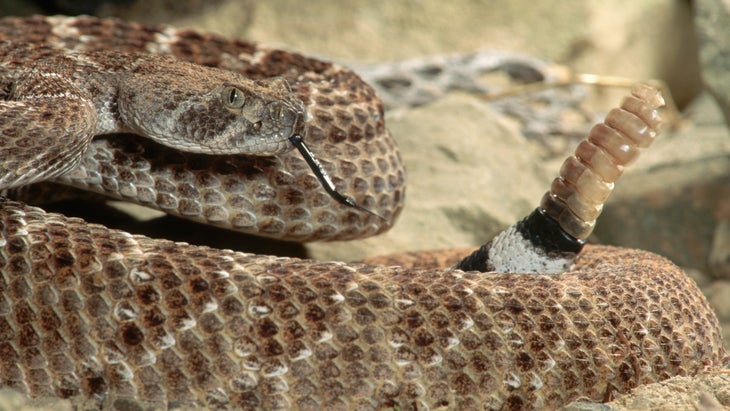
Rattlesnakes
Rattlers are a standard sight on trails across the U.S., particularly within the arid southwest, the place hikers could encounter them basking in open areas or taking shelter underneath rocks. However for a way widespread they’re, bites are very uncommon: In response to the Pure Historical past Museum of Los Angeles County, they and the opposite three teams of venomous snakes within the U.S.—cottonmouths, copperheads, and coral snakes—collectively chunk 7,000 to eight,000 folks yearly—0.0025 p.c of the U.S. inhabitants. Solely about 5 of these folks die, that means that your probabilities of demise by snakebite are roughly 1 / 4 of your probabilities of demise by lightning.
What to Do If You See (or Hear) a Rattlesnake
First off: don’t contact it. That will sound like a no brainer, however a majority of snakebites—two-thirds, in accordance with one examine from researchers in West Virginia—are “illegitimate,” that means the individual in query provoked or tried to deal with the snake. When you hear a rattle, freeze in place instantly to offer your self time to determine the place it’s coming from. Give the snake a large berth—no less than 6 ft, ideally extra. Don’t wave your trekking poles on the snake or attempt to drive it away, as these actions are prone to agitate it extra.
Rattlesnakes typically (although not all the time) warn off perceived threats with their eponymous rattle, so go away your earphones out in case you’re on a path the place you may encounter them. And look the place you’re strolling: Step on, not over, rocks, logs, and different obstacles to keep away from the prospect of unintentionally treading on one.
Case Examine: Pacific Crest Path, California
In June 2023, a hiker suffered a chunk from a rattlesnake on the PCT close to Tehachapi, California whereas mountain climbing with three different folks. In response to The Trek, the opposite hikers managed to name for assist. Rescuers dispatched by the Kern County Fireplace Division reached the group on off-road automobiles and gave the bitten hiker first help till a helicopter was capable of airlift them to a hospital, the place they made a full restoration.
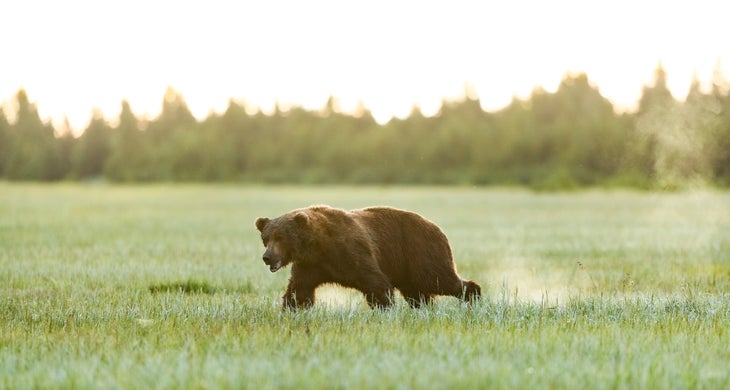
Bears
Actually and figuratively, bears are bigger than life. They’re the most important predators that the majority hikers will ever encounter, and due to the eye their assaults on folks garner, they’ve a fame to match. Numbers-wise, although, they’re even much less prone to kill you than a rattlesnake: Grizzlies kill a mean of two to three folks per 12 months in North America, whereas black bears kill fewer than one. Most grizzly assaults are defensive and contain moms with cubs, whereas black bears usually tend to be behind predatory assaults. Stopping shock encounters by making noise, mountain climbing in a gaggle, and retaining canines on leash can cut back the potential of a run-in.
What to Do if You See a Bear
Keep calm; kind a gaggle along with your mountain climbing companions, converse to the bear in a peaceful, agency voice, and provides the bear an opportunity to go away. If in case you have bear spray (it is best to), get it out and get it prepared. If the bear prices, deploy your bear spray in a brief burst when it’s roughly 50 ft away; your intention is to make a cloud of spray that the animal should undergo earlier than it reaches you.
If the bear makes contact, what you do subsequent relies upon fully on what sort of bear it’s. If it’s a black bear, it’s possible making an attempt to make a meal out of you. Attempt to escape to a automobile or constructing—neglect about getting up a tree, you possibly can’t climb in addition to a black bear—and if that’s not attainable, struggle again. If it’s a grizzly, the assault is probably defensive. Lay in your abdomen along with your arms clasped behind your neck, unfold your legs to make it more durable to flip you over, and look forward to the bear to go away.
Case Examine: Anchorage, Alaska
In July 2025, a hiker known as 911 and reported that she had been mauled by a brown bear within the Stuckagain Heights space close to Anchorage and couldn’t hike out on her personal. Firefighters, law enforcement officials, and personnel from the Bureau of Land Administration and state fish and sport company situated the hiker with a drone and evacuated her by way of helicopter with what they described as non-life-threatening accidents.
Later that week, a brown bear sow mauled one other hiker in the identical space after his off-leash canine encountered her and her cub. That hiker managed to cease the assault by spraying the bear, then spraying it once more after it returned. In feedback to the media after the assaults, wildlife officers famous that the encounters occurred close to a stream the place bears congregate to feed on salmon.
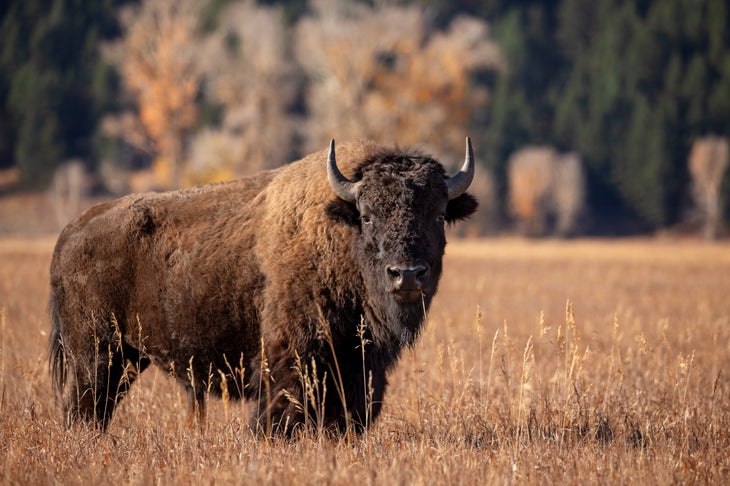
Bison
They might look placid, however these kissing cousins of home cattle weigh as much as a ton, run quick sufficient to interrupt residential velocity limits, and may hit like a truck. Additionally they have a low tolerance for vacationers’ foolishness, inflicting extra accidents in Yellowstone Nationwide Park than every other animal. The park recorded 25 customer accidents from bison between 2000 and 2015, although—fortunately—no deaths.
What to Do if You See a Bison
Say it with us: Don’t pet the fluffy cows. With some grace for individuals who encounter bison on twisty, turny trails with low visibility, most bison assaults on hikers are a results of poor decision-making. Keep no less than 25 yards away from bison always. (Don’t understand how far that’s? Use the rule of thumb: Stick your hand out at arms size, shut one eye, and attempt to cowl the animal along with your thumb. When you can see any a part of it protruding, again up.) Bison blocking the path? Wait, discover one other route, or give it a large, vast berth. If a bison prices, your greatest wager is to run and search cowl behind a stable object.
Case Examine: Antelope Island State Park, Utah
In 2019, Kyler Bourgeous was working on Antelope Island close to Salt Lake Metropolis when he stunned a bison from the park’s resident herd. The animal charged him, leaving him with puncture wounds to his armpit and hip and a fractured rib. In an interview with the CBC, Bourgeous stated he had simply crested a hill on the time of the encounter, and had not seen the bison till he was “means too shut.”
Just a few months after the incident, Bourgeous went again to Antelope Island with a date, Kayleigh Davis. Their plan was for Davis, who was coaching for a half-marathon, to run a path within the park after which meet up for the sundown. In a merciless coincidence, Davis additionally obtained attacked by a bison, sustaining a damaged ankle and a deep minimize to her calf.
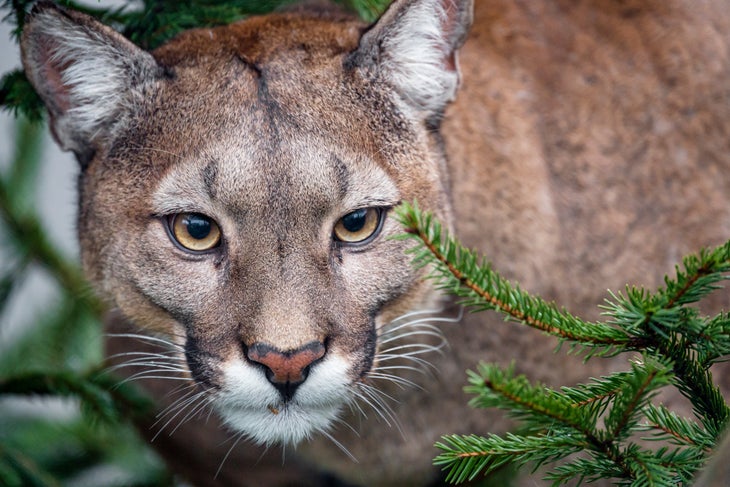
Cougars
Puma, cougar, mountain lion, catamount: Name them what you need, however this massive feline’s means to maneuver silently by way of the forest and penchant for ambushing its prey conjures up a stage of concern in hikers that far outstrips its precise hazard. Previously 135 years, cougars have solely been answerable for 130 assaults and 28 fatalities on folks in North America. Most of these unfortunate folks have been lone youngsters or adults, although a small minority had been pairs or trios unfold out sufficient that the cat possible didn’t see them as a part of a gaggle.
What to Do if You See a Cougar
Recognizing a cougar may be very uncommon. Like most of their family, mountain lions typically don’t prefer to face off with their prey, and largely keep away from folks. Prevention is vital: When you’re in an space with mountain lion exercise, journey in a gaggle, particularly in case you’re path working or biking, which can provoke the cat’s chase intuition.
Within the distinctive occasion you encounter a cougar, don’t run or bend over, each of which can set off an assault. As a substitute, make your self as large as attainable by elevating your arms, lifting up youngsters, and opening your jacket. Face the cat and converse firmly and loudly—your purpose is to persuade it you’re not prey. Within the extraordinarily unlikely occasion of an assault, struggle again with rocks, sticks, bear spray, or your fists and ft.
Case Examine: Georgetown, California
In March 2024, brothers Taylen and Wyatt Brooks had been shed looking once they encountered a cougar. Whereas the 2 made themselves as massive as attainable and shouted, the cougar attacked them, pouncing on Wyatt first. The pair fought again, and the cougar turned on Taylen, grabbing him by the throat. Wyatt first tried unsuccessfully to get the cougar off of his brother, then ran to his truck to search for cell service to name 911. When officers arrived, they discovered the cougar guarding Taylen, who was deceased; wildlife officers later trapped and euthanized the animal. The incident was California’s first deadly mountain lion assault in 20 years.
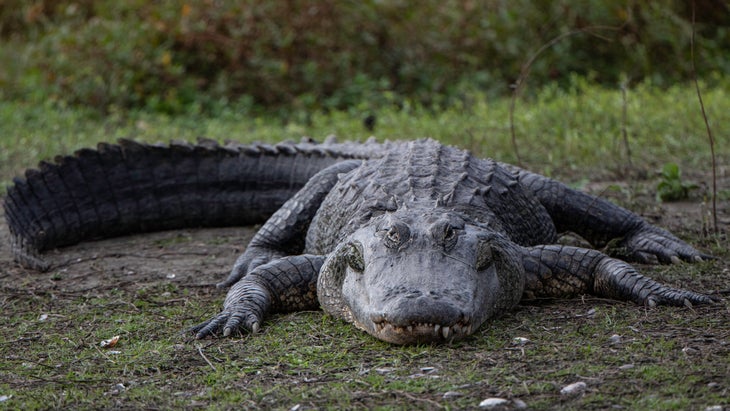
Alligators
Within the mid-Twentieth century, gators had been so uncommon in Florida that they had been listed as endangered. Since then, the species has undergone a exceptional restoration: As we speak, there are an estimated 1.3 million alligators throughout all 67 of Florida’s counties, they usually’re a standard sight in all places from the depths of the Everglades to roadside ditches. Your odds of getting chomped are nonetheless low, although: Between 1948 and 2024, 487 folks suffered unprovoked bites from gators, of which simply 27 died.
What to Do if You See a Gator
The ability is in your arms right here: Your odds of getting a run-in with an alligator are a lot increased within the water than they’re on land, and one examine from College of Florida and Kentucky’s Centre School discovered that 96 p.c of incidents had been preceded by folks taking pointless dangers like strolling canines close to our bodies of water or swimming in lakes or rivers the place not allowed.
However what in case you do discover an alligator on or by the path you’re mountain climbing? First off, hold your distance—no less than 30 ft. If the gator hisses at you, it thinks you’re too shut. If one does run at you, e book it: Whereas alligators are fast, they’ve poor endurance on land and can nearly all the time hand over the chase when you’ve vacated their house. Use additional warning round our bodies of water at daybreak, nightfall, and in the course of the evening, when gators are typically extra lively. Within the extraordinarily uncommon occasion that one assaults, struggle again, concentrating on the eyes and nostril, till it lets go.
Case Examine: Everglades Nationwide Park, Florida
In 2020, an 18-year-old school scholar was mountain climbing within the Everglades along with her professor and 14 different college students. Whereas wading alongside a flooded path close to the Pahayokee Overlook, a feminine alligator grabbed the coed by her decrease proper leg. NPS spokesperson Allyson Gantt advised press that the coed had sustained two small “low-pain” puncture wounds. Gantt famous that the path is standard with hikers and that alligator assaults there are extraordinarily uncommon, and reminded guests that the park recommends towards swimming.
Observe





















